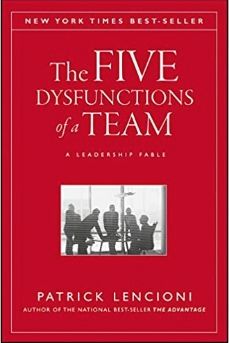Bestseller and business consultant Patrick Lencioni uses a fable to explain how to engage teams, increase their commitment and make sure they meet their goals.

More Effective Teams
Patrick Lencioni offers a fable about an executive striving to run a company and create a smoothly functioning executive team. Lencioni’s fable is interesting to a point, and you can read through it easily, getting to know the characters and participating in their business decisions. However, if you want to glean Lencioni’s worthy, no-nonsense advice about achieving better teamwork quickly, skim to the final chapters, in which the author offers a detailed model for diagnosing the five dysfunctions of a team and provides exercises and techniques to ameliorate those dysfunctions.
His advice is complete and concrete, as in his other bestsellers. Lencioni, president of The Table Group, a San Francisco consultancy, is the author of 10 business books, including Getting Naked and Silos, Politics and Turf Wars – with three million copies sold.
The Story
Lencioni’s story opens with the new CEO of Decision Tech, Kathryn Peterson, trying to cope with an executive team in chaos. She learns valuable lessons while creating a functional team. The author posits team building as conceptually simple, uncluttered and straightforward. Lencioni cites the five pitfalls or dysfunctions with which all teams must cope: lack of trust, fear of confrontation, absence of commitment, lack of accountability and a failure to focus on goals.
Organizations fail to achieve teamwork because they unknowingly fall prey to five natural but dangerous pitfalls.Patrick Lencioni
By contrast, Lencioni notes, successful team members trust each other and debate and discuss any issues without reservation or rancor. They make decisions and resolve to act according to plans. Crucially, the author notes, they hold each other to account and keep their eyes on the prize: meeting the team’s goals.
Dysfunction 1: Lack of Trust
Lencioni makes clear that, in the context of teams, trust means confidence that each member has good intentions. Trust, he clarifies, is not confidence in teammates’ performance; trust is confidence that teammates will not slip a knife in your back.
Teamwork deteriorates if even a single dysfunction is allowed to flourish.Patrick Lencioni
When they trust each other, Lencioni says, teammates can attend to the task at hand without worrying about what political game or Machiavellian maneuver might be unfolding. The author’s blunt cynicism is refreshing, as is his faith that people can prove him wrong.
He recognizes that trust is difficult to attain in a business context because business teaches people to compete and to project a bold, invulnerable front.
Dysfunction 2: Fear of Confrontation
Confrontations and conflict are necessary goods, Lencioni maintains, not necessary evils. He concedes a vast difference between good and bad confrontations: Good confrontations are honest, open and goal-directed, while bad confrontations are contests for ego or political advantage. Lencioni advises teaching everyone to accept that confrontation and conflict are necessary goods and can be managed productively.
Dysfunction 3: Absence of Commitment
Lencioni’s theme – in his fable and his straightforward advice – is that teams are effective when every member understands, endorses and commits to the team’s acknowledged goals. To further commitment, Lencioni recommends making decisions by consensus, choosing a clear decision rather than procrastinating, wrapping up every meeting with a summary of that day’s decisions, setting and holding to clear deadlines, using scenarios to imagine best and worst-case outcomes, and committing to low-stakes decisions, which help build the commitment muscle to attack bigger, weightier issues.
Dysfunction 4: Absence of Accountability
When team members are uncomfortable holding each other to commitments or pointing out problems or deficiencies, Lencioni insists, the team cannot progress. A team member may be unaware of a problem and may need feedback from the rest of the team or from the leader. Properly directed and expressed, he believes, peer pressure can be a source of support and encouragement.
Building accountability, the author teaches, involves making goals and responsibilities clear, using progress reviews and reports to motivate performance, establishing a venue in which team members can hold each other accountable, and offering team-based, not individual, rewards.
Dysfunction 5: Failure to Focus on Goals
Lencioni reiterates throughout that when members don’t pursue their team’s agenda or focus on personal objectives instead of the team’s objective, the team loses. To improve performance, he urges team members to commit publicly to the team’s goals. To help them focus on the team’s objectives, Lencioni advises, make results public and tie rewards to those results.
Sometimes strong leaders naturally create an accountability vacuum within the team, leaving themselves as the only source of discipline.Patrick Lencioni
When team members achieve their goals, he recommends, pay them a bonus and reward them well. However, Lencioni is sternly adamant that you should never reward a team that does not meet its goals.
No Accident
Lencioni hasn’t sold three million books by accident. While his fable may prove less than compelling, as fiction goes, and may incite in you the urge to flip pages forward, it does provide a few jewels of metaphorical advice. The section of advice that ends the book proves why business readers flock to Lencioni. He states his advice in basic, scannable prose and with the contagious attitude that what he tells you is the only commonsense course to follow. He’s remarkably convincing.
Lencioni’s compassionate understanding of the difficulties people encounter transcending their egos and trusting anyone in a group setting is unusual for an author with his certainty. His advice takes human nature into account, and he reminds leaders to expect inconsistency and to react, as he does, with kindness backed up by total commitment to deadlines and achieving goals.
Patrick Lencioni’s other books include The Four Obsessions of an Extraordinary Executive, The Five Temptations of a CEO, Death By Meeting, The Ideal Team Player, The Motive and The Advantage.




